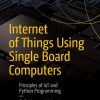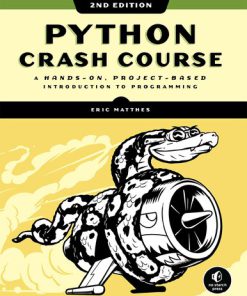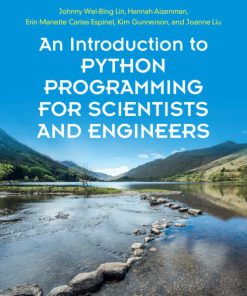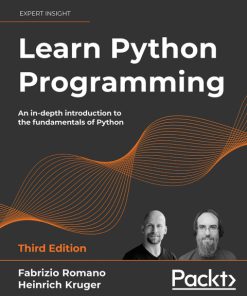Python An Introduction to Programming 2nd Edition by Jim Parker 1683926242 9781683926245
$50.00 Original price was: $50.00.$25.00Current price is: $25.00.
Python An Introduction to Programming 2nd Edition by Jim Parker- Ebook PDF Instant Download/Delivery: 1683926242, 9781683926245
Full download Python An Introduction to Programming 2nd Edition after payment
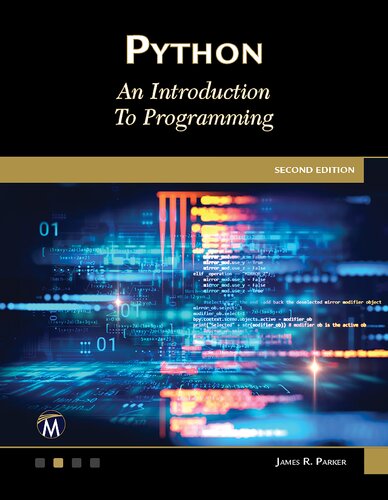
Product details:
ISBN 10: 1683926242
ISBN 13: 9781683926245
Author: James R. Parker
This book is an introduction to programming concepts that uses Python 3 as the target language. It covers basic computer concepts such as loops, strings, functions, files, graphics, multimedia, algorithms, classes, writing code, etc. Many examples are based on video games because Python has become the language of choice for basic game development. It follows a practical just in time presentation – material is given to the student when it is needed. Designed as a year one textbook for introduction to programming classes or for the hobbyist who wants to learn the fundamentals of programming, the text assumes no programming experience. Companion files with source code, solved programming exercises, projects, and figures from the text are included.
Python An Introduction to Programming 2nd Table of contents:
Chapter 0: Modern Computers
0.1 Calculations by Machine
0.2 How Computers Work and Why We Made Them
0.2.1 Numbers
Example: Base 4
Convert Binary Numbers to Decimal
Convert Decimal Numbers to Binary
Arithmetic in Binary
0.2.2 Memory
0.2.3 Stored Programs
0.3 Computer Systems Are Built in Layers
0.3.1 Assemblers and Compilers
0.3.2 Graphical User Interfaces (GUIs)
Widgets
0.4 Computer Networks
0.4.1 Internet
0.4.2 World Wide Web
0.5 Representation
0.6 Summary
Chapter 1: Computers and Programming
1.1 Solving a Problem Using a Computer
1.2 Executing Python
1.3 Guess a Number
1.4 Rock–Paper–Scissors
1.5 Solving the Guess a Number Problem
1.6 Solving the Rock-Paper-Scissors Problem
1.6.1 Variables and Values–Experimenting with the Graphical User Interface
1.6.2 Exchanging Information with the Computer
1.6.3 Example 1: Draw a Circle Using Characters
1.6.4 Strings, Integers, and Real Numbers
1.6.5 Number Bases
1.6.6 Example 2: Compute the Circumference of Any Circle
1.6.7 Guess a Number Again
1.7 IF Statements
1.7.1 Else
1.8 Documentation
1.9 Rock-Paper-Scissors Again
1.10 Types Are Dynamic (Advanced)
1.11 Summary
Chapter 2: Repetition
2.1 The WHILE Statement
2.1.1 The Guess-A-Number Program Revisited
2.1.2 Modifying the Game
2.2 Rock–Paper–Scissors Revisited
2.2.1 Random Numbers
2.3 Counting Loops
2.4 Prime or Non-Prime
2.4.1 Exiting from a Loop
2.4.2 Else
2.5 Loops That Are Nested
2.6 Draw a Histogram
2.7 Loops in General
2.8 Exceptions and Errors
2.8.1 Problem: A Final Look at Guess a Number
2.9 Summary
Chapter 3: Sequences: Strings, Tuples, and Lists
3.1 Strings
3.1.1 Comparing Strings
3.1.2 Slicing – Extracting Parts of Strings
3.1.3 Editing Strings
3.1.4 String Methods
3.1.5 Spanning Multiple Lines
3.1.6 For Loops Again
3.2 The Type Bytes
3.3 Tuples
3.3.1 Tuples in For Loops
3.3.2 Membership
3.3.3 Delete
3.3.4 Update
3.3.5 Tuple Assignment
3.3.6 Built-in Functions for Tuples
3.4 Lists
3.4.1 Editing Lists
3.4.2 Insert
3.4.3 Append
3.4.4 Extend
3.4.5 Remove
3.4.6 Index
3.4.7 Pop
3.4.8 Sort
3.4.9 Reverse
3.4.10 Count
3.4.11 List Comprehension
3.4.12 Lists and Tuples
3.4.13 Exceptions
3.5 Set Types
3.5.1 Example: Craps
3.6 Summary
Chapter 4: Functions
4.1 Function Definition: Syntax and Semantics
4.1.1 Problem: Use the function poundn to Draw a Histogram
4.1.2 Problem: Generalize the Histogram Code for Other Years
4.2 Function Execution
4.2.1 Returning a Value
4.2.2 Parameters
4.2.3 Default Parameters
4.2.4 None
4.2.5 Example: The Game of Sticks
4.2.6 Scope
4.2.7 Variable Parameter Lists
4.2.8 Variables as Functions
Example: Find the maximum value of a function
4.2.9 Functions as Return Values
4.3 Recursion
4.3.1 Avoiding Infinite Recursion
4.4 Creating a Python Module
4.5 Program Design Using Functions–The Game of Nim
4.5.1 The Development Process Exposed
4.6 Summary
Chapter 5: Files: Input and Output
5.1 What Is a File? A Little Theory
5.1.1 How Are Files Stored on a Disk?
5.1.2 File Access is Slow
5.2 Keyboard Input
5.2.1 Problem: Read a number from the keyboard and divide it by 2
5.3 Using Files in Python: Less Theory, More Practice
5.3.1 Open a File
File Not Found Exceptions
5.3.2 Reading from Files
End of File
Common File Input Operations
CSV Files
The With Statement
5.4 Writing to Files
Example: Write a table of squares to a file.
5.4.1 Appending Data to a File
Example: Append another 20 squares to the table of squares file.
5.5 Summary
Chapter 6: Classes
6.1 A Casual Introduction to Classes
6.2 Classes and Types
6.3 Classes as Encapsulated Modules
6.4 Classes as Data Abstractions
6.5 The Python Class – Syntax and Semantics
6.5.1 A Really Simple Class
6.5.2 Encapsulation
6.6 Classes and Data Types Again
6.6.1 Example: A Deck of Cards
6.6.2 A Bouncing Ball
6.6.3 Cat-A-Pult
Basic Design
Detailed Design
6.7 Subclasses and Inheritance
6.7.1 Non-Trivial Example: Objects in a Video Game
6.8 Duck Typing
6.9 Summary
Chapter 7: Graphics
7.1 Introduction to Graphics Programming
7.2 Graphics in Python–Pygame
7.3 Initializing Pygame
7.3.1 Colors
7.4 The Event LOOP
7.5 Drawing
Example: Create a Page of Note Paper
Example: Creating a Color Gradient
7.5.1 Lines and Curves
Example: Note Paper Again
7.6 Arcs and Curves
7.6.1 Polygons
7.6.2 Text
7.6.3 Example: A Histogram
7.6.4 Example: A Pie Chart
7.6.5 Images
Pixels, Again
Example: Identifying a green car
Example: Thresholding
Transparency
7.6.6 Generative Art
7.7 Summary
Chapter 8: Manipulating Data
8.1 Dictionaries
8.1.1 Example: A Naïve Latin – English Translation
8.1.2 Functions for Dictionaries
8.1.3 Dictionaries and Loops
8.2 Arrays
8.3 Formatted Text, Formatted I/O
8.3.1 Example: NASA Meteorite Landing Data
8.4 Advanced Data Files
8.4.1 Binary Files
Example: Create a File of Integers
8.4.2 The Struct Module
Example: A Video Game High Score File
8.4.3 Random Access
Example: Maintaining the High Score File in Order
8.5 Standard File Types
8.5.1 Image Files
8.5.2 GIF
8.5.3 JPEG
8.5.4 TIFF
8.5.5 PNG
8.5.6 Sound Files
8.5.7 WAV
8.5.8 Other Files
8.5.9 HTML
8.5.10 EXE
8.6 Summary
Chapter 9: Multimedia
9.1 Mouse Interactions
Example: Draw a Circle at the Mouse Cursor
Example: Change Background Color Using the Mouse
9.1.1 Mouse Buttons
Example: Draw Lines Using the Mouse
Example: A Button
9.2 The Keyboard
Example: Pressing a “q” Creates a Random Circle
Example: Reading a Character String
9.3 Animation
9.3.1 Object Animation
Example: A Ball in a Box
Example: Many Balls in a Box
9.3.2 Frame Animation
Example: Read Frames and Play Them Back as an Animation
Example: Simulation of the Space Shuttle Control Console (A Class That Will Draw an Animation at a Specific Location)
9.4 RGBA Colors – Transparency
9.5 Sound
Example: Play a Sound
Example: Control Volume Using the Keyboard
Example: Play a Sound Effect at the Right Moment: Bounces
Music
9.6 Summary
Chapter 10: Basic Algorithms
10.1 Sorting
10.1.1 Selection Sort
10.1.2 Merge Sort
10.2 Searching
10.2.1 Timings
10.2.2 Linear Search
10.2.3 Binary Search
10.3 Random Number Generation
10.3.1 Linear Congruential Method
10.4 Cryptography
10.4.1 One-Time Pad
10.4.2 Public Key Encryption (RSA)
10.4.3 Example: Encrypt the Message “Depart at Dawn” Using RSA
10.5 Compression
10.5.1 Huffman Encoding
10.5.2 LZW Compression
10.6 Hashing
10.6.1 DJB2
10.6.2 SDBM
10.7 Summary
Chapter 11: Programming for the Sciences
11.1 Finding Roots of Equations
11.2 Differentiation
11.3 Integration
11.4 Optimization: Finding Maxima and Minima
11.4.1 Newton Again
11.4.2 Fitting Data to Curves – Regression
11.4.3 Evolutionary Methods
11.5 Longest Common Subsequence (Edit Distance)
11.5.1 Determining Longest Common Subsequence (LCS)
11.5.2 NumPy
11.5.3 One Dimensional Arrays (Vectors)
11.5.4 Two Dimensional Arrays (Matrices)
11.5.5 Sample Problem: Finding Paths
11.5.6 Linear Regression Again
11.6 Summary
Chapter 12: How To Write Good Programs
12.1 Procedural Programming – Word Processing
12.1.1 Top-Down
12.1.2 Centering
12.1.3 Right Justification
12.1.4 Other Commands
12.2 Object Oriented Programming – Breakout
12.3 Describing the Problem as a Process
12.3.1 Initial Coding for a Tile
12.3.2 Initial Coding for the Paddle
12.3.3 Initial Coding for the Ball
12.3.4 Collecting the Classes
12.3.5 Developing the Paddle
12.3.6 Ball and Tile Collisions
12.3.7 Ball and Paddle Collisions
12.3.8 Finishing the Game
12.4 Rules for Programmers
12.5 Summary
Chapter 13: Communicating with the Outside World
13.1 Email
Example: Sending an email
13.1.1 Reading email
13.1.2 Example: Display the Subject Headers for Emails in the Inbox
13.2 FTP
13.2.1 Example: Download and Display the README File from an FTP Site
13.3 Communication Between Processes
13.3.1 Example: A Server That Calculates Squares
13.4 Twitter
13.4.1 Example: Connect to the Twitter Stream and Print Specific Messages
13.5 Communicating with Other Languages
13.5.1 Example: Find Two Large Relatively Prime Numbers
13.6 Summary
Chapter 14: Parsing–The Structure of Data
14.1 Grammars
14.2 PYJ and JULIA
14.3 Language Symbols and Scanning
14.4 Parsing a Programming Language
14.5 WHILE Statements
14.6 FOR Statements
14.7 IF Statements
14.8 Expressions
14.9 Functions
14.10 Examples
Chapter 15: Communicating Using Graphics: Windows, User Interfaces, and Pygame
15.1 A Paint Program
Interface
15.2 Building the Mondrean Interface
15.3 Selecting
15.4 The Buttons
Drawing
15.5 Images and Surfaces
15.6 Stacks: Undraw and Redraw
15.7 Color Selection
15.8 Image File Selection
People also search for Python An Introduction to Programming 2nd:
python programming an introduction to computer science 2nd edition pdf
python an introduction to programming pdf
introduction to computing and programming in python 4th edition pdf
python programming an introduction to computer science 3rd ed
Tags:
James Parker,Python,Introduction,Programming
You may also like…
Computers - Programming
Python Crash Course A Hands On Project Based Introduction to Programming 2nd Edition Eric Matthes
Computers - Computer Science
An Introduction to Programming and Computer Science with Python First Edition Clayton Cafiero
Computers - Programming
Computers - Programming
Computers - Computer Science Computers - Programming
An Introduction to Parallel Programming 2nd Edition Peter Pacheco
Computers - Programming
Uncategorized
Computers
Learn Python Programming An in depth introduction to the fundamentals of Python 3rd Edition Romano

